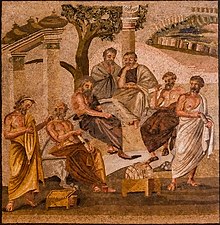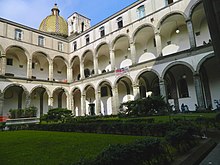|
Ancient higher-learning institutions
 A variety of ancient higher-learning institutions were developed in many cultures to provide institutional frameworks for scholarly activities. These ancient centres were sponsored and overseen by courts; by religious institutions, which sponsored cathedral schools, monastic schools, and madrasas; by scientific institutions, such as museums, hospitals, and observatories; and by certain scholars. They are distinct from the Western-style university, an autonomous organization of scholars that originated in medieval Europe[1] and has been adopted in other regions in modern times (see list of oldest universities in continuous operation).[2] AfricaNorth AfricaEgyptAncient Egyptians established an organization of higher learning – the Per-ankh, which means the "House of Life" – in 2000 BCE.[3][4] In the third century BCE, amid the Ptolemaic dynasty, the Serapeum, Mouseion, and Library of Alexandria served as organizations of higher learning in Alexandria.[5][4] In Cairo, Al-Azhar, which was established in 970 CE, served as an organization of higher learning.[6][4] MoroccoIn Fez, Fatima al-Fihri established a madraza in 859 CE, which eventually became the organization of higher learning, the currently named University of al-Qarawiyyin.[6][4] TunisiaThe Ez-Zitouna University, which was established in 732 CE as Al-Zaytuna Mosque, served as an organization of higher learning.[4] West AfricaMaliIn the twelfth century CE, the University of Sankore, which began as the Mosque of Sankore, served as an organization of higher learning in Timbuktu.[6][4] The Mosque of Sankore, the Mosque of Sidi Yahya, and the Mosque of Djinguereber constitute what is referred to as the University of Timbuktu.[6][4] East AfricaEthiopiaIn the fourth century CE, amid the reign of Emperor Ella Amida, the Axumite imperial church served as an organization of higher learning.[3][4] AsiaSouth AsiaMajor Buddhist monasteries (mahaviharas), notably those at Pushpagiri, Nalanda, Valabhi, and Taxila, included schools that were some of the primary institutions of higher learning in ancient India. The Salai in South India such as Kanthalloor Salai, Parthivapuram Salai served the same purpose. Nalanda Nalanda was established in the fifth century CE in Bihar, India,[7] and survived until circa 1200 CE. It was devoted to Buddhist studies, but it also trained students in fine arts, medicine, mathematics, astronomy, politics and the art of war.[9] Evidence in literature suggests that in 1193, Nalanda mahavihara was sacked by[10] Bakhtiyar Khilji.[11] The Persian historian Minhaj-i-Siraj, in his chronicle the Tabaqat-i-Nasiri, reported an attack on a Buddhist monastery in which all the Buddhist monks were killed. This may have been Nalanda but others believe it was Odantapuri.[12] In 2014 the modern Nalanda University was launched in nearby Rajgir. Pushpagiri The school in Pushpagiri was established in the third century CE as present Odisha, India. As of 2007, the ruins of this Mahavihara had not yet been fully excavated. Consequently, much of the Mahavihara's history remains unknown. Of the three Mahavihara campuses, Lalitgiri in the district of Cuttack is the oldest. Iconographic analysis indicates that Lalitgiri had already been established during the Shunga period of the second century BCE, making it one of the oldest Buddhist establishments in the world. The Chinese traveller Xuanzang (Hiuen Tsang), who visited it in 639 CE, as Puphagiri Mahavihara,[13][14] as well as in medieval Tibetan texts. However, unlike Takshila and Nalanda, the ruins of Pushpagiri were not discovered until 1995, when a lecturer from a local college first stumbled upon the site.[15][16] The task of excavating Pushpagiri's ruins, stretching over 58 hectares (143 acres) of land, was undertaken by the Odisha Institute of Maritime and South East Asian Studies between 1996 and 2006. It is now being carried out by the Archaeological Survey of India (ASI).[17] The Nagarjunakonda inscriptions also mention about this learning center.[18][19] TaxilaAncient Taxila or Takshashila, in ancient Gandhara, present-day Pakistan, was an early Buddhist centre of learning. According to scattered references that were only fixed a millennium later, it may have dated back to at least the fifth century BCE.[20] Some scholars date Takshashila's existence back to the sixth century BCE.[21] The school consisted of several monasteries without large dormitories or lecture halls where the religious instruction was most likely still provided on an individualistic basis.[20] Takshashila is described in some detail in later Jātaka tales, written in Sri Lanka around the fifth century CE.[22] It became a noted centre of learning at least several centuries BCE, and continued to attract students until the destruction of the city in the fifth century CE. Takshashila is perhaps best known because of its association with Chanakya. The famous treatise Arthashastra (Sanskrit for The knowledge of Economics) by Chanakya, is said to have been composed in Takshashila itself. Chanakya (or Kautilya),[23] the Maurya Emperor Chandragupta[24] and the Ayurvedic doctor Charaka studied at Taxila.[25] Generally, a student entered Takshashila at the age of sixteen. The Vedas and the Eighteen Arts, which included skills such as archery, hunting, and elephant lore, were taught, in addition to its law school, medical school, and school of military science.[25] VikramashilaVikramashila was one of the two most important centres of learning in India during the Pala Empire, along with Nalanda. Vikramashila was established by King Dharmapala (783 to 820) in response to a supposed decline in the quality of scholarship at Nalanda. Atisha, the renowned pandita, is sometimes listed as a notable abbot. It was destroyed by the forces of Muhammad bin Bakhtiyar Khilji around 1200.[26] Vikramashila is known to us mainly through Tibetan sources, especially the writings of Tāranātha, the Tibetan monk historian of the sixteenth and seventeenth centuries.[27] Vikramashila was one of the largest Buddhist universities, with more than one hundred teachers and about one thousand students. It produced eminent scholars who were often invited by foreign countries to spread Buddhist learning, culture and religion. The most distinguished and eminent among all was Atisha Dipankara, a founder of the Sarma traditions of Tibetan Buddhism. Subjects like philosophy, grammar, metaphysics, Indian logic etc. were taught here, but the most important branch of learning was tantrism.[citation needed] OtherFurther centres include Odantapuri, in Bihar (circa 550 – 1040), Telhara in Bihar[28] (probably older than Nalanda[29]), Somapura Mahavihara and Jagaddala Mahavihara in Bengal, Kanchipuram, in Tamil Nadu, Manyakheta, in Karnataka, Nagarjunakonda, in Andhra Pradesh, Sharada Peeth, Somapura Mahavihara, in Bangladesh, Valabhi, in Gujarat, Varanasi in Uttar Pradesh, Vikramashila, in Bihar (circa 800–1040), Mahavihara, Abhayagiri Vihāra, and Jetavanaramaya, in Sri Lanka.[citation needed] East AsiaChinaIn China, the ancient imperial academy known as Taixue was established by the Han dynasty. It was intermittently inherited by succeeding Chinese dynasties up until the Qing dynasty, in some of which the name was changed to Guozixue or Guozijian. Peking University (Imperial University of Peking) and Nanjing University are regarded as the replacement of Taixue. By 725 CE, Shuyuan or Academies of Classical Learning were private learning institutions established during the medieval Chinese Tang dynasty. The Yuelu Academy (later become Hunan University) founded in 976 CE, which is one of the four ancient famous Shuyuan (Academies) during the Song dynasty.[30] JapanIn Japan, Daigakuryo was founded in 671 and Ashikaga Gakko was founded in the ninth century and restored in 1432.[citation needed] KoreaIn Korea, Taehak was founded in 372 and Gukhak was established in 682. Seowons were private institutions established during the Joseon dynasty which combined functions of a Confucian shrine and a preparatory school. The Seonggyungwan was founded by in 1398 to offer prayers and memorials to Confucius and his disciples, and to promote the study of the Confucian canon. It was the successor to Gukjagam from the Goryeo dynasty (992). It was reopened as Sungkyunkwan University, a private Western-style university, in 1946.[citation needed] Ancient PersiaThe Academy of Gondishapur was established in the third century CE under the rule of Sassanid kings and continued its scholarly activities up to four centuries after Islam came to Persia. It was an important medical centre of the sixth and seventh centuries and a prominent example of higher education model in pre-Islam Persia.[31] EuropeClassical Greece The Platonic Academy (sometimes referred to as the University of Athens),[32][33] founded ca. 387 BCE in Athens, Greece, by the philosopher Plato, lasted until 86 BCE, when it was destroyed during Sulla's siege and sacking of Athens.[34] Some 400 years later, during the fourth century CE, the Platonist philosopher Plutarch of Athens started a school which identified itself with Plato's Academy that lasted until 529, when it was closed following an edict from the Emperor Justinian prohibiting pagans from teaching.[35] Around 335 BCE, Plato's successor Aristotle founded the Peripatetic school, the students of which met at the Lyceum gymnasium in Athens. The school also ceased in 86 BC during the famine, siege and sacking of Athens by Sulla.[36] Christian Europe  The University of Constantinople, founded as an institution of higher learning in 425, educated graduates to take on posts of authority in the imperial service or within the Church.[39] It was reorganized as a corporation of students in 849 by the regent Bardas of emperor Michael III, is considered by some to be the earliest institution of higher learning with some of the characteristics we associate today with a university (research and teaching, auto-administration, academic independence, et cetera). If a university is defined as "an institution of higher learning" then it is preceded by several others, including the Academy that it was founded to compete with and eventually replaced. If the original meaning of the word is considered "a corporation of students" then this could be the first example of such an institution. The Preslav Literary School and Ohrid Literary School were the two major literary schools of the First Bulgarian Empire.[citation needed] In Western Europe during the Early Middle Ages, bishops sponsored cathedral schools and monasteries sponsored monastic schools, chiefly dedicated to the education of clergy. The earliest evidence of a European episcopal school is that established in Visigothic Spain at the Second Council of Toledo in 527.[40] These early episcopal schools, with a focus on an apprenticeship in religious learning under a scholarly bishop, have been identified in Spain and in about twenty towns in Gaul during the sixth and seventh centuries.[41] In addition to these episcopal schools, there were monastic schools which educated monks and nuns, as well as future bishops, at a more advanced level.[42] Around the turn of the twelfth and thirteenth centuries, some of them developed into autonomous universities. A notable example is when the University of Paris grew out of the schools associated with the Cathedral of Notre Dame, the Monastery of Ste. Geneviève, and the Abbey of St. Victor.[43][44] Italian universities are among the oldest universities in the world; the University of Bologna (founded in 1088) notably, is the oldest one ever; also, University of Naples Federico II (founded in 1224) are is the world's oldest state-funded university in continuous operation.[37][38] See also
References
Notes
External links
|